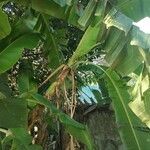Pseudostems clumped, yellow-green, often with large, black markings, ca. 6 m. Petiole 60--75 cm, margin open, ca. 2 cm wide, often closed when young; leaf blade adaxially green and slightly pruinose or not, ovate-oblong, ca. 2.9 m × 90 cm, base auriculate, asymmetric. Inflorescence pendulous, ca. 2.5 m; peduncle and rachis glabrous. Bracts of bisexual and male flowers adaxially purple-red, abaxially brownish purple to yellow-green and pruinose, ovate to lanceolate, persistent, apex obtuse, reflexed after flowering; bracts of female flowers deciduous. Male flowers up to 20 per bract, in 2 rows. Compound tepal adaxially pale purple, abaxially pale purple-white, 4--5 cm, striate, teeth yellow to orange; free tepal milky white, translucent, obovate, ca. 1/2 as long as compound tepal, apex emarginate, shortly mucronate-apiculate. Infructescence pendulous, with ca. 8 clusters (“hands”) each of 15 or 16 berries in 2 rows. Berries gray-green, obovoid, ca. 13 × 4 cm, distinctly angled at maturity, base narrowed into a stalk ca. 2.5 cm, apex contracted or not into a short, angled column ca. 2 cm. Seeds numerous, brown, oblate, 5--10 mm in diam., minutely warty. 2 n = 22.
More
A large herb. It grows 3-10 m tall. It keeps growing from year to year by re-growing new stalks from the underground root stock. The leaves are green and 3 m long. The flowers are purple. The fruit are pale yellow. They are 3 sided and 8 cm long. The fruit have seeds. This is the small diploid. The flower is pink and yellow and resembles a lotus bud. The fruit are in an upright spike. It needs pollination to produce seeds. Many bananas are hybrids between acuminata and balbisiana. See Musa x paradisiaca


